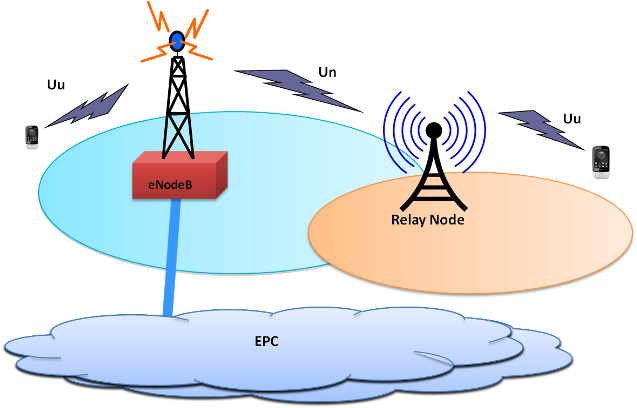For efficient heterogeneous network planning, 3GPP LTE-Advanced has introduced concept of Relay Nodes (RNs). The Relay Nodes are low power eNodeBs that provide enhanced coverage and capacity at cell edges. One of the main benefits of relaying is to provide extended LTE coverage in targeted areas at low cost.
For efficient heterogeneous network planning, 3GPP LTE-Advanced has introduced concept of Relay Nodes (RNs). The Relay Nodes are low power eNodeBs that provide enhanced coverage and capacity at cell edges. One of the main benefits of relaying is to provide extended LTE coverage in targeted areas at low cost.
The Relay Node is connected to the Donor eNB (DeNB) via radio interface, Un, a modified version of E-UTRAN air interface Uu. Donor eNB also srves its own UE as usual, in addition to sharing its radio resources for Relay Nodes.

The Relay Node supports the eNB functionality meaning it terminates the radio protocols of the E-UTRA radio interface, and the S1 and X2 interfaces. In addition to the eNB functionality, the RN also supports a subset of the UE functionality, e.g. physical layer, layer-2, RRC, and NAS functionality, in order to wirelessly connect to the DeNB.
With respect to the relay node’s usage of spectrum, its operation can be divided into inband and outband types. For both inband and outband relaying, it is possible to operate the eNB-to-relay link on the same carrier frequency as eNB-to-UE links. 3GPP Release 8, UEs can connect to the donor cell in both cases.
At least “Type 1” and “Type 1a” RNs are supported by LTE-Advanced. A “Type 1” RN is an inband RN characterized, A Type 1a relay node is characterized by the same set of features as the Type 1 relay node, except “Type 1a” operates outband.
The donor eNB (DeNB) is enhanced to provide S1 and X2 proxy functionality between the RN and other network nodes (other eNBs, MMEs and S-GWs). The S1 and X2 proxy functionality includes passing UE-dedicated S1 and X2 signalling messages as well as GTP data packets between the S1 and X2 interfaces associated with the RN and the S1 and X2 interfaces associated with other network nodes. Due to the proxy functionality, the DeNB appears as an MME (for S1-MME), an eNB (for X2) and an S-GW (for S1-U) to the RN.
